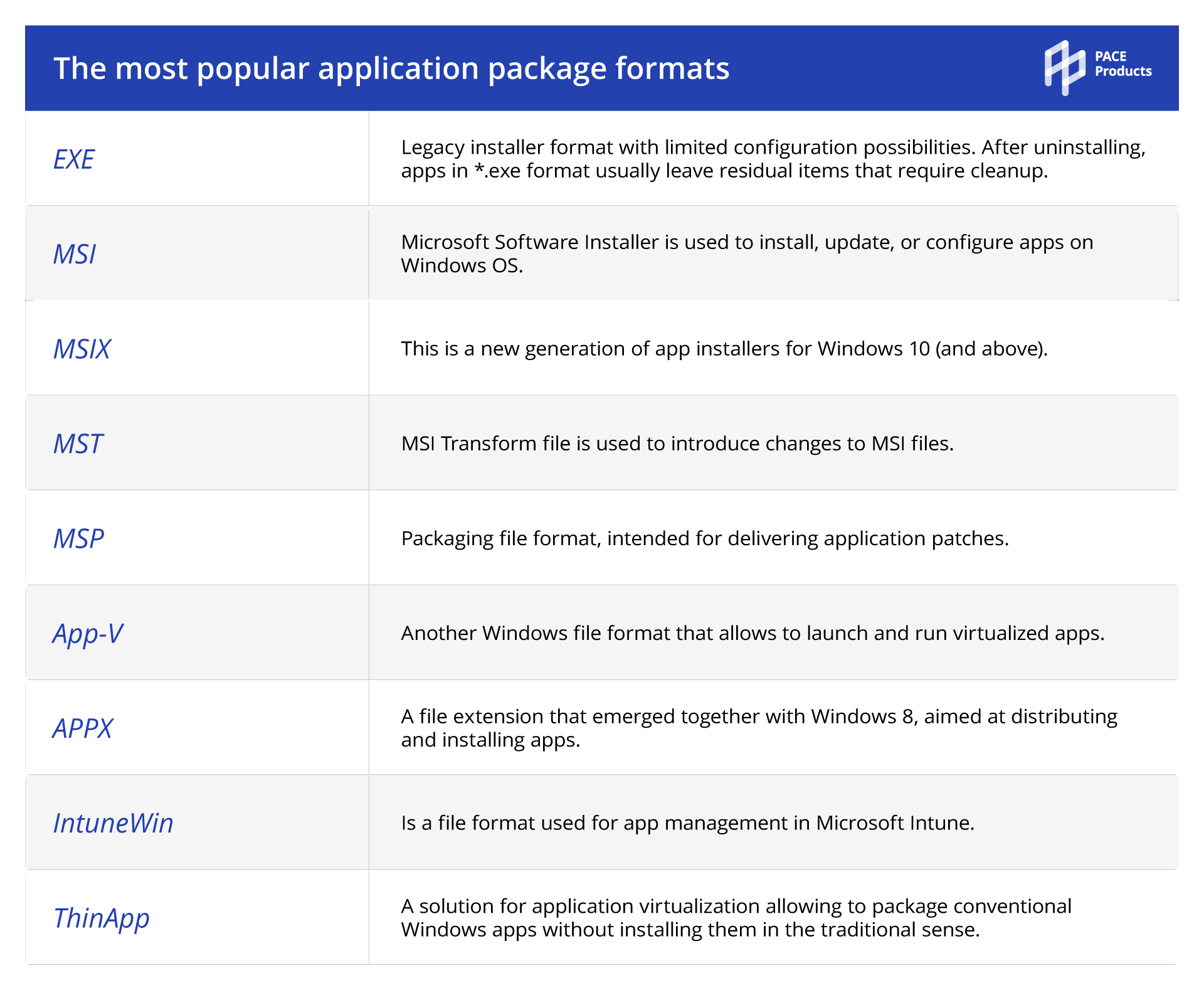Software packaging has undergone lots of changes since 1994 when a sort of early package managers emerged. So did the installers themselves, evolving from .exe files to virtual ones.
Today, we’ll discover what are the types of application packages, which of them are on the rise, how they differ, and what to do if you need to upgrade or change package file format occasionally.
Common App Package Formats
All packages can be divided into two types, depending on the wrapping method: virtual and non-virtual ones. We’ve already mentioned them while covering application packaging basics.
Now, let’s focus on what package formats are there.

Let’s review some of those app package formats in detail.
EXE
EXE extension is one of the most popular “executable” files. They are used for installing software on computers running on Windows.
Unlike data files, EXE files are compiled into binary machine code. After launch, they give the processor instructions on how to execute the program.
MSI
MSI file is a core part of an installation package used by Windows Installer. These files contain everything to set up an app: a database and information streams for diverse application components.
You can configure features, properties, and custom actions for each installer. You can also use MSI packages for uninstalling, upgrading, or repairing software.
Self-healing is a key feature of MSI files. It works for an already installed application when something (files, registry keys) is inconsistent.
Discover how to create MSI Installer with software packaging tool PACE Suite.
MSIX
MSIX package is the next generation of traditional Windows installers. Its main distinctive features are:
- Creation of the Universal Windows Platform (UWP) apps
- Installation per user, not per machine
- Clean uninstallation
Additionally, MSIX files are more secure. Also, it runs in a container, minimizing the influence on the OS, works faster, and allows for optimizing storage usage.
Despite all those benefits, it comes with a few limitations. For instance, the MSIX package doesn’t support driver installation.
To find out more about Windows installers, read our article MSI vs MSIX: An Ultimate Overview and Comparison.
APPX
APPX package format was introduced in 2013, for installing software on Windows 8 (and higher). One may call it even a predecessor of MSIX, as APPX is also used for packaging UWP apps.
Typically, these packages are ready for publishing, distribution across organizations, and installation. Similar to MSIX, you can get APPX package installed per user. But just like MSIX, it has its technical restrictions, e.g. overloading the Windows registry.
Some engineers still use them, yet, with the rise of MSIX in 2018, APPX package became less popular.
APP-v
App-V file format stands for virtual apps that are installed on the servers and distributed to end users with no need to install them locally. It helps to minimize possible conflicts and impact of the software on other applications and the OS itself.
The main issue with App-V packages is that as of April 2026, Microsoft will no longer upgrade the technology. In fact, this means end-of-life for App-V apps, and we recommend repackaging to another format, like MSIX before that date.
Get more details about that in our Overview of applications packaging software trends.
IntuneWin
IntuneWin packages are used in Microsoft Intune, a cloud-based solution for mobile device management and app distribution (which was originally launched as Windows Intune in April 2010).
To start using it, you’ll need to either create new applications in .intunewin format or repackage the existing Win32 ones.
To automate the process and make it easier, you can do that with an IntuneWin package tool, like PACE Suite. Check out our short Guide on the simple and fast creation of IntuneWin packages. In case of any questions, be sure to get in touch with us.
To Conclude
As you can see, there are multiple package types. Some of them are rather a legacy, and the other ones are quite promising. Yet, there’s no one-size-fits-all solution. In some cases, it might be more reasonable to keep using the old package types instead of repackaging them to the brand-new format. It’s only up to you, which of them to choose or migrate to, depending on your needs.
In case you still decide to move to the new package types, our PACE Suite is here to cover all of your packaging needs. With it, you can quickly repackage and configure any installer into the format you need via a user-friendly interface.
To seize the full capabilities of PACE Suite, start your free trial today.

